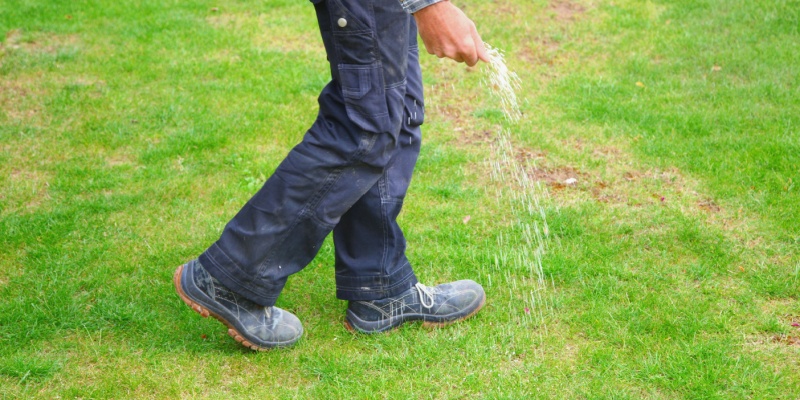Keeping your lawn looking great in Reynoldsburg, OH, requires more than regular mowing and watering. One of the most effective strategies for preventing weeds and promoting healthy grass growth is proper lawn fertilization. Fertilizing your lawn not only enhances its aesthetic appeal but also creates an environment where desirable grass species can outcompete invasive weeds.
Understanding the Connection Between Fertilization and Weed Prevention
Weeds and grass compete for the same essential resources: sunlight, water, and nutrients. When your lawn is well-fertilized, the grass grows thicker and stronger, effectively crowding out weeds and reducing their ability to establish themselves. Here’s how fertilization contributes to weed prevention:
1. Enhanced Grass Growth:
Adequate fertilization promotes vigorous growth of your grass, making it denser and more resilient. A thick lawn leaves less space and fewer resources available for weeds to thrive.
2. Improved Root Systems:
Fertilizers rich in nutrients like nitrogen help develop robust root systems. Strong roots allow grass to access deeper water sources, making it harder for shallow-rooted weeds to compete.
3. Healthier Grass Plants:
Well-nourished grass is less susceptible to diseases and pests, which can otherwise create openings for weeds to invade.
4. Balanced Soil Nutrients:
Proper fertilization ensures that your soil has the right balance of nutrients, creating an optimal environment for grass growth while inhibiting weed proliferation.
Fertilization Schedule for Optimal Weed Control
Timing your fertilization efforts is crucial for effective weed prevention. Here’s a recommended fertilization schedule tailored to Reynoldsburg’s climate:
Early Spring (March-April):
- Objective:
Promote early grass growth and prepare the lawn for the growing season.
- Action:
Apply a balanced, slow-release fertilizer high in nitrogen to encourage lush, dense grass growth. This helps outcompete early-season weeds like chickweed and dandelions.
Late Spring (May-June):
- Objective:
Strengthen the lawn’s growth as temperatures rise.
- Action:
Use a fertilizer with a higher nitrogen content to maintain vigorous growth. This supports the lawn’s ability to resist summer weeds such as crabgrass and spurge.
Mid-Summer (July-August):
- Objective:
Maintain grass health during the peak of the growing season.
- Action:
Apply a potassium-rich fertilizer to enhance drought resistance and overall turf strength, reducing the likelihood of weed invasion during hot, dry periods.
Early Fall (September-October):
- Objective:
Prepare the lawn for winter and prevent winter weeds.
- Action:
Use a balanced fertilizer with a focus on phosphorus to support root development and overall lawn resilience. This helps the grass recover from summer stress and prevents winter annual weeds like henbit from establishing.
Late Fall (November):
- Objective:
Ensure the lawn is well-prepared for winter dormancy.
- Action:
Apply a slow-release, winterizer fertilizer high in potassium to strengthen the grass against cold temperatures and reduce the chances of weed germination in the spring.
Additional Tips for Effective Lawn Fertilization and Weed Prevention
1. Soil Testing:
Conduct a soil test to determine the specific nutrient needs of your lawn. Soil testing helps you choose the right fertilizer blend and avoid over-fertilization, which can promote weed growth.
2. Proper Application:
Follow the manufacturer’s instructions for fertilizer application rates and methods. Uneven or excessive application can lead to patchy grass growth and create opportunities for weeds to establish.
3. Mowing Practices:
Maintain your grass at the recommended height for your specific grass type. Taller grass shades the soil, reducing weed seed germination and enhancing the lawn’s overall density.
4. Watering Techniques:
Water deeply and infrequently to encourage deep root growth. Avoid overwatering, which can weaken grass and make it more susceptible to weed invasion.
5. Integrated Weed Management:
Combine fertilization with other weed control methods, such as manual removal, mulching, and the use of pre-emergent herbicides. An integrated approach ensures comprehensive weed prevention and lawn health.
The Benefits of Professional Lawn Care Services
While DIY fertilization can be effective, partnering with a professional lawn care service like WeedBustersOnline.com offers several advantages:
- Expertise and Knowledge:
Professionals understand the specific needs of Reynoldsburg lawns and can tailor fertilization plans to maximize weed prevention and grass health.
- Customized Solutions:
Customized fertilizer blends and application schedules ensure that your lawn receives the precise nutrients it needs at the right times.
- Time and Convenience:
Professional services save you time and effort, allowing you to enjoy a beautiful, weed-free lawn without the hassle of managing fertilization on your own.
- Ongoing Support:
Regular lawn care maintenance and monitoring by professionals help sustain long-term lawn health and weed resistance.
Lawn fertilization is a cornerstone of effective weed prevention in Reynoldsburg, OH. By providing your grass with the essential nutrients it needs to grow thick and strong, fertilization creates an environment where weeds struggle to compete. Implementing a strategic fertilization schedule, choosing the right fertilizer, and adopting proper lawn care practices can transform your yard into a lush, weed-resistant oasis. For optimal results and professional guidance, consider partnering with Weed Busters. Our expertise and customized lawn care solutions can help you achieve and maintain a beautiful, healthy lawn year-round.

